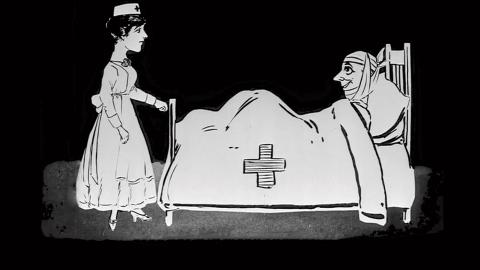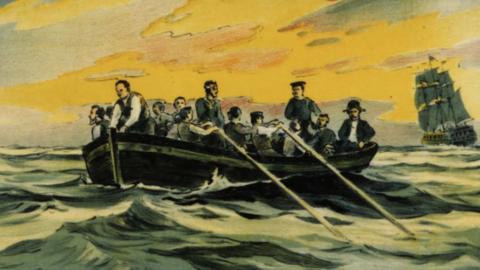

Harry Julius' cartoons of war
During the 2015 centenary of Australian animation and the four-year commemoration of the First World War, the NFSA is preserving the Cartoons of the Moment of ‘lightning’ sketch artist and caricaturist Harry Julius.
In 1915, Harry Julius provided a regular satirical commentary on local and world events through his Cartoons of the Moment, screened in cinemas as part of The Australian Gazette.
The following clip features eight short segments about the First World War, most of which date from January-June 1915 (explanations below):
Animator Harry Julius’ Cartoons of the Moment segments for The Australian Gazette, 1915. NFSA title: 35093
Julius was satirising, and producing propaganda about, current events and so the newspapers of the time (accessed via Trove) are the best source of information about the stories behind these cartoons.
The new handy man – This segment is about JW Rickaby, an English comedian on tour in Australia in late 1914-early 1915. Rickaby was famous for performing the song ‘PC 49’, about a hapless police constable. The song was a staple of English comedy, having its beginnings in the late 19th century and remaining popular into the mid 20th century. In early 1915 there were also news snippets about ‘The Handy Man’ in the fighting forces who applied his skills to the task at hand, but the exact meaning of the reference in the cartoon remains obscure.
Photograph of Rickaby as PC 49 in Saturday Referee, 9 January 1915, p6 »
Short review of Rickaby’s Sydney shows in Punch, 21 January 1915, p29 »
German road of death – This segment refers to the deaths caused by the Germans advancing towards Verdun. Hostilities at Verdun lasted for most of 1916 and resulted in hundreds of thousands of deaths on both sides. In the cartoon, Germany’s Crown Prince Wilhelm trades soldiers’ lives with the symbolic figure of Death to pave his ‘way to glory’.
That zep raid – On 19 January 1915, a German Zeppelin L45 dropped bombs on and around the Royal Sandringham estate. King George V was in London at the time and was unharmed. ‘Willy’ refers to Germany’s Crown Prince Wilhelm.
German ‘Culture’ in The Brisbane Courier, 21 January 1915 p7 »
Admirable Beatty! – In December 1914 German ships bombed three British towns killing men, women and children. In January 1915 British Admiral Beatty finds one of the German ships and destroys it.
The Naval Raid in The Sydney Morning Herald, 18 December 1914, p9 »
Still Gaining Ground in The Adelaide Advertiser, 22 December 1914, p7 »
Naval Battle: Admiral Beatty sinks the Blucher in Sydney Mail, 27 January 1915, p7 »
Counting the chickens – In mid-1915 newspapers reported that Germany was beginning to admit miscalculations in their strategic planning, particularly concerning the unity of the British Empire. Julius references the old saying, ‘Don’t count your chickens before they hatch’.
Dawning of the Truth in The Mail, 5 June 1915, p22 »
The Australians form the backbone of the Allied troops landed against the Turks – This is the text of a cable from General Sir Ian Hamilton, commander-in-chief of the Dardanelles expeditionary forces. It heralds what we now commemorate as the Gallipoli campaign. The Australians (represented by a kangaroon wielding a rifle fitted with a bayonet) and Turks (represented by a turkey wearing a fez) had fought against each other in Egypt.
Colonial Troops For Dardanelles in The Sydney Morning Herald, 23 April 1915, p9 »
At Ypres the Canadians rallied magnificently… – In April 1915, the Germans used poison gas in their fight with French soldiers at Ypres. Canadian troops came to the aid of the French.
The Yser: Enemy Held in The Sydney Morning Herald, 27 April 1915, p9 »|
About Cartoons of the Moment
In January 1915, Australia’s largest film production company, Australasian Films, commissioned Harry Julius to provide a satirical commentary on the news for their nationally distributed weekly cinema newsreel, The Australian Gazette. Until that point no series of locally-produced cartoons had screened in cinemas, only imported animation.
Once only available on fragile nitrate film the NFSA is preserving them on durable 35mm polyester film and as digital files for easy accessibility.
The National Film and Sound Archive of Australia acknowledges Australia’s Aboriginal and Torres Strait Islander peoples as the Traditional Custodians of the land on which we work and live and gives respect to their Elders both past and present.

